The dismantling of an Engine can occur for one of several reasons, for example, as a result of failure, symptoms of impending failure, or because the unit has reached its predetermined age of overhaul. For whatever reason an overhaul represents a golden opportunity to enhance the performance of predictive maintenance. The observations made during rebuild are indispensable for CBM optimization through EXAKT analysis. The overhaul reveals a set of clear life cycle sample points at the failure mode level.
A Failure Mode is an event that causes a change in a part resulting in the loss of a required system function. Failure modes of a major component (for example, an engine, or a final drive) can be identified accurately only upon disassembly. We must not presume that when an equipment in the fleet exhibits a symptom, for example an anomolous vital sign or a high oil analysis result, that this alone determines a failure sample point for an EXAKT model. The failure must be confirmed visually by the rebuilders or failure analysts. Only then should it be used as a point in a sample for any kind of reliability analysis.
Conversely, an engine that is rebuilt as a result of having reached its predetermined useful life could still, neverthless, present damage or advanced wear to the extent that it is judged to have “potentially” failed. That is, failure is considered, in the judgment of the technicians or failure analyst, imminent within hours or days. Obviously, to make such a judgment, the organization must, through consensus among technicians and failure analysts, gradually develop standards for distinguishing between suspension and failure. Photographic records and other rich information are helpful.
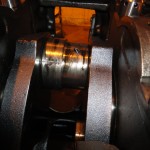 |
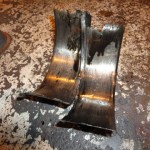 |
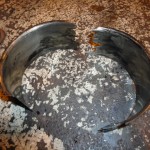 |
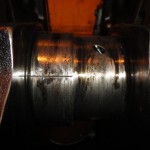 |
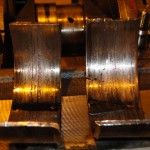 |
The scheduled disassembly of an Engine at age 18988 hours detected advanced wear of the connecting rod bearings at positions 7 and 8. The photos show the condition of the crankshift at position B7-A7 and the connecting rod bearings at positions B7-A7, B8-A8. At the other crankshaft postions wear was much less pronunced and considered “normal”.
The failure analysts can usually identify the failure mode directly responsible for failure. In addition they may also identify potential failures occurring elsewhere in the engine. A standardized investigative process provides the detailed information about the engine’s actual state at the moment of disassembly. The true states of each relevant failure mode constitute sample points for the development of a decision model. The more accurate the identification of the failure mode and its ending event (Failure or Suspension), the more confidence can be entrusted to the decisions flowing from the model.
A disassembled engine, whether it has failed functionally or not, is a rich source of information vital to reliability analysis. The engine reveals its secrets of failure mode behavior completely for us. Typically however, Engines which have completed their scheduled life prior to rebuild are not subjected to failure analysis. Consequently it is assumed, mistakenly that all failure modes in the engine were suspended rather than to have potentially failed. The error of this assumption is clear in the case depicted above. Ignoring or mistaking potential failure for suspension and will result in CBM decsion models having poor prediction performance.
© 2011, Javier Custode. All rights reserved.
